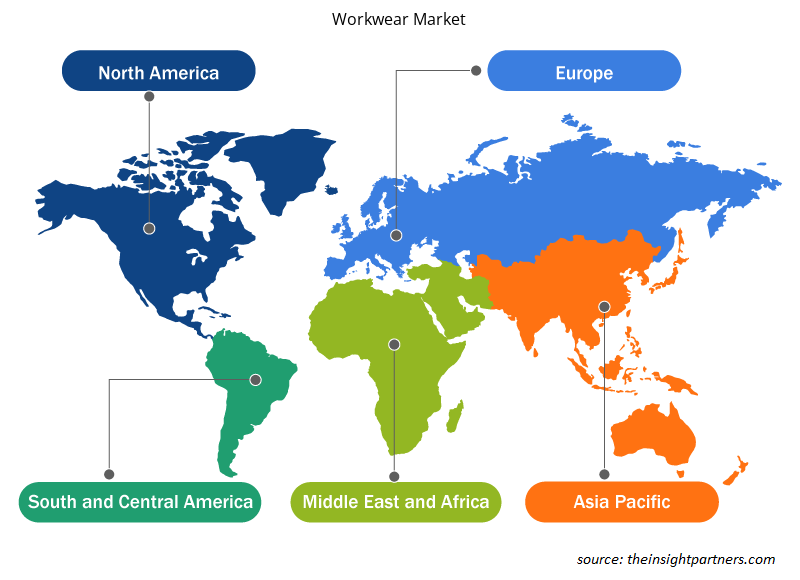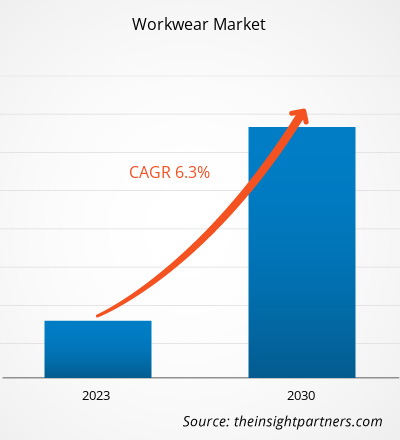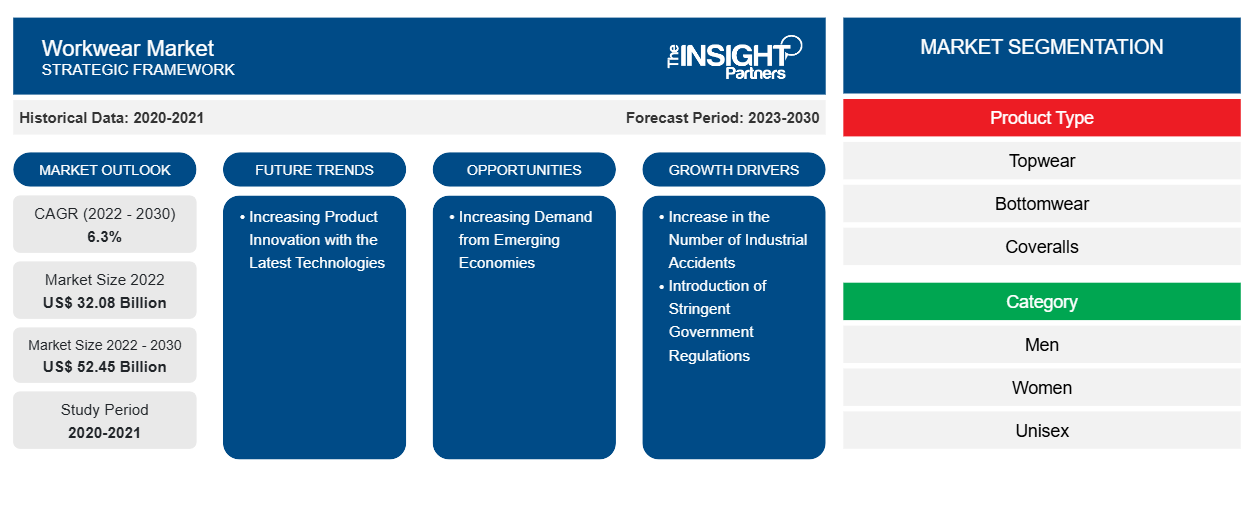[Forschungsbericht] Der Markt für Arbeitskleidung soll von 32.078,76 Millionen US-Dollar im Jahr 2022 auf 52.448,15 Millionen US-Dollar im Jahr 2030 wachsen; von 2022 bis 2030 wird für den Markt eine durchschnittliche jährliche Wachstumsrate (CAGR) von 6,3 % erwartet.
Markteinblicke und Analystenansichten:
Arbeitskleidung besteht aus Sicherheitskleidung und -uniformen, die bei der Arbeit getragen werden, insbesondere bei Arbeiten, die körperliche Arbeit beinhalten . Sie fördern die Sicherheit des Arbeiters und sorgen für eine gesunde Arbeitsumgebung. Arbeitskleidung wird in verschiedenen Branchen häufig verwendet, darunter Öl und Gas, Chemie, Bauwesen, Gesundheitswesen, Gastgewerbe, Landwirtschaft, Bergbau und andere. In den letzten Jahren haben die Sicherheitsbedenken in verschiedenen Industriezweigen rapide zugenommen. Verschiedene Regierungen und Sicherheitsverbände erlassen Branchenrichtlinien, um die Sicherheit der Arbeiter zu gewährleisten, was die Nachfrage nach Arbeitskleidung in die Höhe getrieben hat .
Wachstumstreiber und Herausforderungen:
Arbeitsunfälle sind in zahlreichen Industriezweigen ein großes Problem. Sie haben schwerwiegende Folgen für die Gesundheit der Menschen. Weltweit ereignen sich in verschiedenen Branchen wie der Baubranche, der Öl- und Gasindustrie sowie dem Bergbau zahlreiche Unfälle. Nach Angaben der Internationalen Arbeitsorganisation ( ILO ) werden jährlich etwa 2,78 Millionen arbeitsbedingte Todesfälle verzeichnet, von denen 2,4 Millionen auf Berufskrankheiten zurückzuführen sind. Darüber hinaus ereignen sich weltweit jährlich etwa 340 Millionen Arbeitsunfälle und 160 Millionen Menschen an berufsbedingten Erkrankungen. Aufgrund der steigenden Zahl von Arbeitsunfällen übernehmen Arbeitgeber verschiedene von nationalen und internationalen Organisationen definierte Standards, um das Wohlbefinden und die Sicherheit ihrer Mitarbeiter am Arbeitsplatz zu gewährleisten. Arbeitskleidung soll den Trägern Schutz und Komfort bieten und ihnen helfen, schwere Todesfälle am Arbeitsplatz zu vermeiden und so die Arbeitseffizienz der Arbeiter zu verbessern. Die funktionale Arbeitskleidung bietet Sicherheit und Haltbarkeit bei der Arbeit in den unterschiedlichsten Industriezweigen. So hat die Zunahme von Arbeitsunfällen und arbeitsbedingten Todesfällen zu einem sprunghaften Anstieg der Nachfrage nach Arbeitskleidung zur Gewährleistung der Sicherheit der Arbeitnehmer geführt, was wiederum zum Wachstum des Arbeitskleidungsmarktes beiträgt .
Darüber hinaus ist der Mangel an Wissen über Arbeitssicherheit und mögliche Gesundheitsgefahren für die Arbeitnehmer weltweit ein großes Problem. Um das Bewusstsein hierfür zu schärfen, führen viele staatliche und nichtstaatliche Organisationen verschiedene Programme und Kampagnen zur Gesundheit und Sicherheit der Arbeitnehmer ein. Laut der American Standard Organization standardisieren in Nordamerika das US-Arbeitsministerium und die Occupational Safety and Health Administration (OSHA) den Bereich der Arbeitssicherheits- und Gesundheitsstandards. Zu den Organisationen, die an der Entwicklung von Standards für Schutzkleidung beteiligt sind, gehören die American Society for Testing and Materials ( ASTM ), die National Fire Protection Association ( NFPA ), das National Institute for Occupational Safety and Health ( NIOSH ), das American National Standard Institute (ANSI), die American Association of Textile Chemists and Colorists ( AATCC ) und die Industrial Safety Equipment Association ( ISEA ). Ein steigendes Bewusstsein für Sicherheit am Arbeitsplatz treibt also das Wachstum des Arbeitskleidungsmarktes erheblich an .
Passen Sie diesen Bericht Ihren Anforderungen an
Sie erhalten kostenlos individuelle Anpassungen an jedem Bericht, einschließlich Teilen dieses Berichts oder einer Analyse auf Länderebene, eines Excel-Datenpakets sowie tolle Angebote und Rabatte für Start-ups und Universitäten.
-
Holen Sie sich die wichtigsten Markttrends aus diesem Bericht.Dieses KOSTENLOSE Beispiel umfasst eine Datenanalyse von Markttrends bis hin zu Schätzungen und Prognosen.
Berichtssegmentierung und -umfang:
Der globale Markt für Arbeitskleidung ist nach Produkttyp, Kategorie, Vertriebskanal, Endverwendung und Geografie segmentiert. Nach Produkttyp ist der Markt in Oberbekleidung , Unterbekleidung und Overalls unterteilt. Nach Kategorie ist der Markt in Herren, Damen und Unisex unterteilt. Nach Vertriebskanal ist der Markt in Großhändler, Supermärkte und Hypermärkte, Fachgeschäfte und Online-Plattformen segmentiert. Nach Endverwendung ist der Markt für Arbeitskleidung in Bauwesen, Öl und Gas, Chemie, Gesundheitswesen und Sonstiges unterteilt. Nach Geografie ist er in Nordamerika (USA, Kanada und Mexiko), Europa (Deutschland, Frankreich, Italien, Großbritannien, Russland und übriges Europa), Asien-Pazifik (Australien, China, Japan, Indien, Südkorea und übriger Asien-Pazifik-Raum), Naher Osten und Afrika (Südafrika, Saudi-Arabien, Vereinigte Arabische Emirate und restlicher Naher Osten und Afrika) und Süd- und Mittelamerika (Brasilien, Argentinien und restliches Süd- und Mittelamerika) segmentiert.
Segmentanalyse :
Basierend auf dem Produkttyp ist der Markt für Arbeitskleidung in Oberbekleidung , Unterbekleidung und Overalls unterteilt . Das Segment Overalls wird im Prognosezeitraum voraussichtlich die höchste durchschnittliche jährliche Wachstumsrate verzeichnen . Overalls sind ein- oder zweiteilige Kleidungsstücke, die zum Schutz des gesamten menschlichen Körpers am Arbeitsplatz getragen werden. Diese Overalls bestehen hauptsächlich aus Nylon-, Baumwoll- und Polyamidfasern . Aufgrund des hohen Risikos berufsbedingter Gefahren werden sie im Allgemeinen in chemischen Verarbeitungsanlagen und Industrien wie Farben und Lacke sowie Öl und Gas verwendet. Diese Faktoren treiben das Marktwachstum für das Segment Overalls voran.
Regionale Analyse:
Geografisch ist der Markt für Arbeitskleidung in fünf Hauptregionen unterteilt: Nordamerika, Europa, Asien-Pazifik, Süd- und Mittelamerika sowie Naher Osten und Afrika. Nordamerika dominiert den Weltmarkt; der Markt in dieser Region wurde im Jahr 2022 auf 8360 Millionen US-Dollar geschätzt. Der Markt in Asien-Pazifik-Amerika wird im Prognosezeitraum voraussichtlich eine durchschnittliche jährliche Wachstumsrate von 7,1 % verzeichnen. Im Jahr 2021 gab die Internationale Arbeitsorganisation (ILO) an, dass im Asien-Pazifik-Raum jedes Jahr mehr als 1,1 Millionen Menschen durch Arbeitsunfälle oder arbeitsbedingte Krankheiten ihr Leben verlieren. Verschiedene Länder im Asien-Pazifik-Raum, wie Indien, haben die am wenigsten geschützte, am wenigsten informierte und am wenigsten ausgebildete Belegschaft. Frauen, Kinder, behinderte Arbeitnehmer, Wanderarbeiter und ethnische Minderheiten sind die am stärksten betroffene Bevölkerungsgruppe und häufig in Arbeitsunfälle verwickelt. Um solche Arbeitsunfälle und Verletzungen zu reduzieren, investieren daher mehrere Branchen, wie das Baugewerbe, die Fertigung sowie die Öl- und Gasindustrie, massiv in die Arbeitssicherheit ihrer Mitarbeiter. Aufgrund der hohen Nachfrage nach Arbeitskleidung wächst der Markt für Arbeitskleidung im asiatisch-pazifischen Raum erheblich.
Branchenentwicklungen und zukünftige Chancen:
Nachfolgend sind die Initiativen der wichtigsten Akteure auf dem Markt für Arbeitskleidung aufgeführt:
- Im Februar 2020 gaben Honeywell International Inc. und Tech Mahindra Limited eine Partnerschaft zur Entwicklung und zum Bau von „Fabriken der Zukunft“ bekannt, bei der branchenführende digitale Technologien zum Einsatz kommen. Die Zusammenarbeit konzentriert sich auf die digitale Transformation und darauf, Kunden in der Fertigungsindustrie zu ermöglichen, noch schneller zu expandieren.
- Im Juli 2020 führte Loyal Textile Mills Limited den Viral Shield ein, eine neue Linie wiederverwendbarer persönlicher Schutzausrüstung (PSA), Masken und Schutzkleidung zum Schutz vor antimikrobieller Aktivität, insbesondere vor dem SARS-CoV-2-Virus.
Regionale Einblicke in den Arbeitskleidungsmarkt
Die regionalen Trends und Faktoren, die den Arbeitskleidungsmarkt im Prognosezeitraum beeinflussen, wurden von den Analysten von Insight Partners ausführlich erläutert. In diesem Abschnitt werden auch die Marktsegmente und die Geografie des Arbeitskleidungsmarkts in Nordamerika, Europa, im asiatisch-pazifischen Raum, im Nahen Osten und Afrika sowie in Süd- und Mittelamerika erörtert.

- Erhalten Sie regionale Daten zum Arbeitskleidungsmarkt
Umfang des Marktberichts über Arbeitskleidung
| Berichtsattribut | Details |
|---|---|
| Marktgröße im Jahr 2022 | 32,08 Milliarden US-Dollar |
| Marktgröße bis 2030 | 52,45 Milliarden US-Dollar |
| Globale CAGR (2022 - 2030) | 6,3 % |
| Historische Daten | 2020-2021 |
| Prognosezeitraum | 2023–2030 |
| Abgedeckte Segmente |
Nach Produkttyp
|
| Abgedeckte Regionen und Länder |
Nordamerika
|
| Marktführer und wichtige Unternehmensprofile |
|
Dichte der Akteure auf dem Arbeitskleidungsmarkt: Die Auswirkungen auf die Geschäftsdynamik verstehen Market Players Density: Understanding Its Impact on Business Dynamics
Der Markt für Arbeitskleidung wächst rasant. Dies wird durch die steigende Nachfrage der Endverbraucher aufgrund von Faktoren wie sich entwickelnden Verbraucherpräferenzen, technologischen Fortschritten und einem größeren Bewusstsein für die Vorteile des Produkts vorangetrieben. Mit der steigenden Nachfrage erweitern Unternehmen ihr Angebot, entwickeln Innovationen, um die Bedürfnisse der Verbraucher zu erfüllen, und nutzen neue Trends, was das Marktwachstum weiter ankurbelt.Workwear Market market is growing rapidly, driven by increasing end-user demand due to factors such as evolving consumer preferences, technological advancements, and greater awareness of the product's benefits. As demand rises, businesses are expanding their offerings, innovating to meet consumer needs, and capitalizing on emerging trends, which further fuels market growth.
Die Marktteilnehmerdichte bezieht sich auf die Verteilung der Firmen oder Unternehmen, die in einem bestimmten Markt oder einer bestimmten Branche tätig sind. Sie gibt an, wie viele Wettbewerber (Marktteilnehmer) in einem bestimmten Marktraum im Verhältnis zu seiner Größe oder seinem gesamten Marktwert präsent sind.
Die wichtigsten auf dem Arbeitskleidungsmarkt tätigen Unternehmen sind:Workwear Market are:
- Carhartt, Inc.
- ARAMARK
- ALSICO-GRUPPE
- Alexandra
- A. LAFONT SAS
Haftungsausschluss : Die oben aufgeführten Unternehmen sind nicht in einer bestimmten Reihenfolge aufgeführt.

- Überblick über die wichtigsten Akteure auf dem ArbeitskleidungsmarktWorkwear Market top key players overview
Auswirkungen der COVID-19-Pandemie:
Die COVID-19-Pandemie hat sich negativ auf fast alle Branchen in verschiedenen Ländern ausgewirkt. Lockdowns, Reisebeschränkungen und Betriebsschließungen in Nordamerika, Europa, im asiatisch-pazifischen Raum (APAC), Süd- und Mittelamerika sowie im Nahen Osten und Afrika (MEA) behinderten das Wachstum mehrerer Unternehmen der Endverbrauchsindustrie. Die Schließung von Produktionseinheiten störte globale Lieferketten, Produktionsaktivitäten, Lieferpläne sowie den Verkauf lebenswichtiger und nicht lebenswichtiger Produkte. Verschiedene Unternehmen erlebten im Jahr 2020 Verzögerungen bei Produktlieferungen und einen Einbruch ihrer Produktverkäufe, was den Markt für Arbeitskleidung behinderte. Der Mangel an Arbeitskräften, das Import- und Exportverbot und die begrenzte Versorgung mit Rohstoffen führten während der COVID-19-Pandemie auch zu einem Stillstand von Betrieben und Prozessen auf der ganzen Welt. Diese Faktoren wirkten sich während der Pandemie negativ auf das Wachstum des Marktes für Arbeitskleidung aus.
Im Jahr 2021 nahmen jedoch viele Volkswirtschaften ihren Betrieb wieder auf, da mehrere Regierungen die zuvor verhängten Beschränkungen aufhoben, was sich positiv auf den Weltmarkt auswirkte. Darüber hinaus durften die Hersteller mit voller Kapazität arbeiten, was ihnen half, die Nachfrage- und Angebotslücken zu überwinden.
Wettbewerbslandschaft und Schlüsselunternehmen:
Carhartt, Inc., Aramark, Alisco Group, Alexandra, 3M, A. LAFONT SAS, Fristads Kansas Group, Hultafors Group, Lakeland Industries, Inc. gehören zu den führenden Akteuren auf dem globalen Markt für Arbeitskleidung. Diese Marktteilnehmer ergreifen strategische Entwicklungsinitiativen, um ihre Geschäfte auszubauen und das Wachstum des Marktes für Arbeitskleidung weiter voranzutreiben.
- Historische Analyse (2 Jahre), Basisjahr, Prognose (7 Jahre) mit CAGR
- PEST- und SWOT-Analyse
- Marktgröße Wert/Volumen – Global, Regional, Land
- Branchen- und Wettbewerbslandschaft
- Excel-Datensatz
Aktuelle Berichte
Verwandte Berichte
Erfahrungsberichte
Grund zum Kauf
- Fundierte Entscheidungsfindung
- Marktdynamik verstehen
- Wettbewerbsanalyse
- Kundeneinblicke
- Marktprognosen
- Risikominimierung
- Strategische Planung
- Investitionsbegründung
- Identifizierung neuer Märkte
- Verbesserung von Marketingstrategien
- Steigerung der Betriebseffizienz
- Anpassung an regulatorische Trends























 Kostenlose Probe anfordern für - Markt für Arbeitskleidung
Kostenlose Probe anfordern für - Markt für Arbeitskleidung